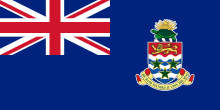CAYMAN ISLANDS
 The Cayman Islands are located in 240 km south of Cuba and 290 km north-west of Jamaica. They represent a territory of 259 sq km. The archipelago is comprised of several islands : Grand Cayman (197 km2), Little Cayman (26 km2), Cayman Brac (36 km2) and Owen Island. Grand Cayman is the largest, the most populated and the most visited island.
The Cayman Islands are located in 240 km south of Cuba and 290 km north-west of Jamaica. They represent a territory of 259 sq km. The archipelago is comprised of several islands : Grand Cayman (197 km2), Little Cayman (26 km2), Cayman Brac (36 km2) and Owen Island. Grand Cayman is the largest, the most populated and the most visited island.
Their relief is quite flat ; the highest peak is The Bluff (over 40 m) that is in Cayman Brac. The islands are parts of enormous submarine mountains which emerge from the sea. The white-sand beaches are numerous.
Several species of bird live in the archipelago : egrets, herons, parrots etc. There are also blue iguanas, lizards, geckos, green turtles…
Among the high trees, there are the manchineel tree and the mahogany. To protect the environment, some parks and reserves have been created : the Queen Elizabeth II Botanic Park which accomodates indigenous species like orchids, iguanas, parrots and birds ; the National Trust Parrot Reserve ; the Bloody Bay Marine Park.
The economy of the archipelago is composed of fishing, shipbuilding, tourism and finance. Indeed, with 600 or 700 banks, Grand Cayman is become the world’s fifth-largest financial center.
Christopher Columbus discovered the Caymans Islands, on May 10, 1503 during his fourth voyage in the New World.
The uninhabited archipelago were occupied by many green turtles then, Columbus named these lands “Turtle Islands”. In the 17th and 18th centuries, the ships which sailed in the Caribbean Sea stopped in the archipelago yo catch turtles whose flesh was savoured.
In 1586, the English pirate Francis Drake landed on the archipelago and named it “Cayman Islands”. With the Treaty of Madrid in 1670, the British oficially appropriated these three islands, but since the war between England and Spain (1655-1660), they already occupied this territory. In the early 18th century, the settlers started arriving from Jamaica. From the 1780s, the shipbuilding industry developed. So, the inter-island trade (with Cuba, Jamaica and Central America) increased. The products sold were coconuts, oxen, jute rope, turtle scales etc… In 1788, because they rescued the occupants of ten ships which left Jamaica to England and were wrecked near Grand Cayman’s coasts, the king George III of England exempted the colony from the payment for taxes ; today, this decision is still in force.
Around 1800, less than 1000 people lived in the archipelago, half of them was African slaves. In 1831, in Bodden Town (the capital until the mid-19th century), the settlers decided choose by a public vote their political representatives.
After the Slavery Abolition Act, in 1834, a lot of freed slaves stayed in the islands. Five years later, the population was comprised of 5000 inhabitants. From1863, the islands were run by Jamaica. Almost one century after, in 1962, Jamaica became independent then, the archipelago was directly in control of Great Britain.
The Cayman Islands are a British overseas territory. A governor appointed by the British Government represents the monarchy in the archipelago. A Primer Minister is the chief of the Caymanian government.
Area : 259 sq km (100 sq miles)
Population : 69 000 inhabitants (2008)
Capital : George Town (Grand Cayman)
Language : English
Currency : Cayman Islands Dollar (CI$)
People : Caymanians
